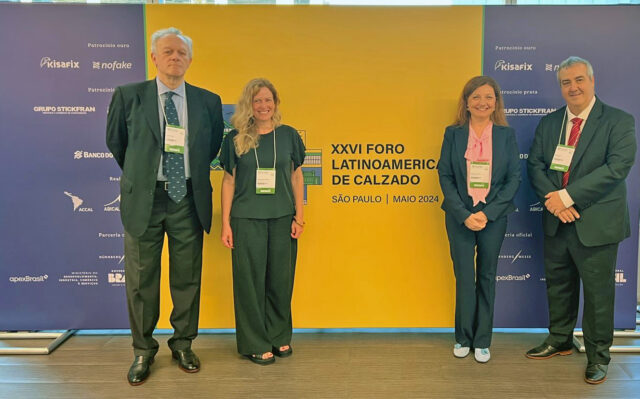The web of encounters woven by the Riva del Garda fair continues worldwide through the Expo Riva Schuh & Gardabags Around the World project.
The latest stop on this journey, aimed at expanding and strengthening the fair’s international relations, was Brazil. Once again, meetings with industry operators, trade associations and entrepreneurs, as well as participation in renowned local trade fairs (like the BFShow in São Paulo) and numerous visits to production districts, allowed the fair’s organisers to better understand the needs of such an important market for this sector. And thus, to offer all stakeholders an event increasingly focused on the industry’s real needs.

THE LATIN AMERICAN FOOTWEAR MARKET
Latin America has a GDP of $6.6 trillion, more than 6% of the global economy, and a population of 665 million. It is for all intents and purposes a huge potential market.
According to data released by Priscila Linck, market analysis coordinator for Abicalçados during the May 2024 edition of the Foro Latinoamericano de Calzado, the Latin-American bloc ranks second globally in footwear production, trailing only Asia. With an annual output exceeding 1.5 billion pairs, the region anticipates a 2%-2.5% boost in its GDP over the next two years, surpassing growth rates seen in many developed economies.
But what are the type and origin of the footwear purchased by Latin-American consumers? Representing consumption, we might add, that is expected to grow by 4% over the next five years. The dependence on Asia is preponderant. In 2023, as a matter of fact, footwear imports in Latin America were close to USD 7 billion for a negative trade balance of 3.6%. Footwear imports from Asia account for 85% of the total.
Data collected by Statista highlight other characteristics of the Latin-American market:
- In 2024, revenue in the South American footwear market is estimated to reach USD 24.61 billion.
- The market is expected to grow annually at a compound annual growth rate (CAGR) of 2.77% from 2024 to 2028.
- Textile footwear, the market’s largest segment, is expected to have a market volume of $12.03 billion in 2024.
- The United States is the bloc’s primary export destination, generating a turnover expected to be around USD 91.51 billion in 2024.
- In 2024, projections suggest that 99% of footwear sales in South America will stem from Non-Luxury brands.
- An exception to this trend is Brazil, where a thriving footwear market is focused specifically on high-quality and fashionable shoes.
There are many challenges facing the South American market, according to Linck: “Ecuador is grappling with an economy heavily reliant on the dollar, leading to inflated costs for domestically manufactured footwear compared to imports. Argentina is facing a triple threat: soaring inflation, stagnant wages and the looming possibility of import liberalisation, which could inundate the market with more affordable alternatives. Nicaragua is striving to attract young talent, while Guatemala contends with the issue of under-invoicing in footwear imports, predominantly from China, eroding the competitiveness of local products.”
LATIN AMERICA AT EXPO RIVA SCHUH & GARDABAGS TO ENTER EUROPE
Brazil, a pivotal hub for global footwear manufacturing, hosted the 26th edition of the Foro Latinoamericano de Calzado. This important event brings together the foremost institutions and influential figures shaping the footwear landscape across South America.

Expo Riva Schuh & Gardabags was there too with its Exhibition Manager, GianPaola Pedretti, the only participant representing an international trade fair, who effectively highlighted the unique attributes of our event to an audience eager to participate in an exhibition that opens the doors to the European market.
“Over the years, Expo Riva Schuh & Gardabags has undoubtedly emerged as the premier platform providing access to the European market for Brazil and South America in general,” explains GianPaola Pedretti. “South American manufacturers come to our fair not only to export their collections, but also as buyers to round out their own domestic offer.”
THE BRAZILIAN INDUSTRIAL FABRIC
There were plenty of visits to Brazilian production facilities in the Santa Caterina district, particularly focused on women’s production, which is largely exported to Latin America, the Middle East and North Africa. Parò, Belli, Di Valentini, LiaLine, Raphaella Booz, Calçados Ala, Suzana Santos were the companies contacted.
No less important was the meeting with the Syndicato della Indústria de Sao João Batista, together with SEBRAE, whose members showed great interest in developing wide-ranging projects with Expo Riva Schuh & Gardabags.Certainly a favourable outcome, in terms of both the contacts made and the array of programs presented involving various South American players. This illustrates how Expo Riva Schuh & Gardabags is not just a trade fair that welcomes visitors to Riva del Garda twice a year. It is much more. Its organisational framework and in-depth market knowledge offer a distinctive advantage to all operators seeking to develop sophisticated business projects and expand their opportunities for export.










